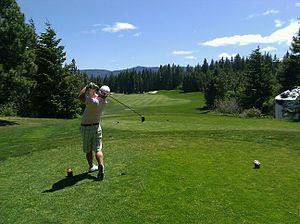
Golfing Meditation
Almost all great golf players in the world consult sport psychologists at one time or another. Many, in fact, have an in-house sport psychologist to advise them while they are on tour. Even great players like the 2005 World No.1, Vijay Singh, confessed to having been guided by a psychologist who specialized in applying Zen meditation technique in the game of golf and who taught him how to cultivate and strengthen awareness using Buddhist Mindful Meditation exercises like body scans, sitting meditation and walking meditation (Parent, 2002).
All golfers know that once you have mastered the basic technique, golf is basically a mental game. The state of the mind is very important during a game. If a golfer fails to concentrate on the golf and allows his mind to run wild with irrelevant thoughts, he can never play well. A lot of these irrelevant thoughts are due to, in Buddhist terminology, too much “attachment”. Here are just a few examples:
· You may have just made a great shot and you are overjoyed. You approach you next shot still savoring the satisfaction with your last shot and you simply forget how to make your next shot as good as the first one.
· Alternatively, you may have just made a stupid shot and you curse yourself for it as you walk up to your next shot. You are so full of negative thoughts that you inevitably foul up your next shot as well.
· You are attached to winning or losing which is going through you mind like a windmill. You walk up to the last putt in the round thinking that if you make this putt, you will win the tournament, and if not… If you cannot get rid of such thoughts when you putt, it is more likely than not that you would not make the putt.
· You are disturbed by some external distraction. May be it is the wind that is blowing too hard, or the noise from other people on the course. You become angry and frustrated and get attached to your emotion.
Mindfulness training will help golfers to maintain their ability to stay with the present moment and to block out distractions and negative thoughts. They would be able to stay calm and eliminate mental mistakes and play with more confidence and concentration. To be able to be Mindful during the golf game, one naturally has to practise off course in the driving range. However, it is equally important to continue training while you are on the course.
Standing on the tee-box
If your mind is filled with negative thoughts, your game will be in a dismal state. For example, when you are standing on the tee, you look at the lake on the right side and you say to yourself, “My God, I am going to hit my ball into the water”. Indeed, your ball will go where your mind does. If not, it will probably swerve so sharply to the left that it would disappear into the woods. Thus, it is important to get rid of any such thoughts.
If you are playing in a foursome game, ask to be the last person to tee-off. This will give you at least 3-4 minutes to bring yourself to the present moment. Look at the green grass on the fairway, listen to the birds, watch the sunrays reflecting off the flowers and feel the breeze caressing your face. Any other thoughts that come into mind, you just note them and let them go. When it is your turn to tee-off, step up to your position, look at the fairway in front of you and visualize where you want to put your tee-shot. While you are taking your practice swing, other thoughts will come in, just note them and let them go and bring yourself to that particular spot you have chosen on the fairway where you want your ball to land. When you are ready for the real swing, exhale completely and note that you are breathing out. Feel the breath moving completely out of you while you focus your eyes on the ball and the dimples or any mark that you may have made on the ball.
Then, as you begin your back swing, take a deep breath in and note, “ I am breathing in…” At the top of the backswing, as you begin the downswing, breath out and note: “I am breathing out…” Do not worry about your form. Your body, hand and arms will just move in whatever way they have been taught to move when you practised your swing in the past in the driving range, irrespective of any conscious effort to co-ordinate the body in making the swing. It must be noted that this breathing exercise must be practised well beforehand in the driving range. The golf course is never a place to teach your muscles how to move. Everything has to come from the subconscious. The more conscious you are of your swing, the less likely you are going to have a good fluid swing, and the more likely for you to have some jerky uncoordinated movements of arms, body and legs.
After the swing, hold your position for a few moments, breathe naturally, and watch where the ball has gone though it does not really matter. You should note that this is something which has happened already and cannot be reversed. There is no need to think about what you are going to do next until you have reached the ball again for your next shot. Just bring yourself back to the present moment and start your approach towards the ball. Your ball may not be in a desired position and you may be frustrated. Note this frustration and then go back to your breathing while you walk away from the tee-box.
Walking to your next shot
Try to play a course that allows you to walk between shots. On courses that make golf cart mandatory, you can still walk as far as possible, asking your playing partner or the caddy to drive the golf cart. While you are walking, practise walking meditation by noting each step. First note the intention to lift the foot and then the lifting-pushing-dropping movement of the limbs. Alternatively, you can concentrate on your breathing: breathing in… breathing out… breathing in… and so forth. As you walk, other thoughts will come into your mind, just note them without judgment and let them go. This will help you to put aside the effect of the last shot on you. You may be elated or frustrated with your performance just now, just note it and let it go and return to your walking meditation. Of course, to avoid slow play, you cannot walk at too slow a pace. That is why it is important to practise walking meditation beforehand as part of your golf practice program so that you can “get into the zone” as soon as you start walking.
Golf is a social game and it is common for golfer buddies to engage in conversation while they are walking in between shots. This would be very distracting. So, if you are intent on practising Mindfulness during your golf game, try to get yourself into a game where you do not know the golfer partners well (as in a tournament competition) or let your partners know beforehand that you would be exceptionally quiet in that particular game and that you are not being anti-social.
Golfing Meditation: Part 2











